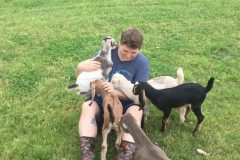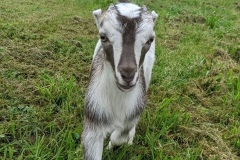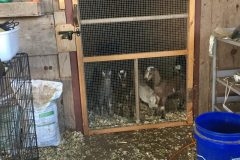This year we ended up with seven (SEVEN!) bottle babies – all boys. They are a mix of breeds. We have (2) Nubians, (3) La Manchas, (1) Mini-La Mancha, and (1) Mini-Nu-Mancha. So how did we get so many? And what in the world is a “bottle baby”? Watch the videos below to learn more!
Feeding time for the bottle babies!
The boys all out playing
A little about bottle babies…
We prefer NOT to have bottle baby goats. Some people DO want them for a variety of reasons. If the goats are part of a dairy operation then the babies are always pulled from their mamas right after they’re born. This is to prevent the spread of disease and to maximize milk production for the dairy. While we do drink our goats milk, we don’t pull the babies away and most homesteaders like us also leave the kids with the mamas. What we will do is separate the mamas and kids at night (after the goat kids are two weeks old) and milk the mamas first thing in the morning. This still leaves lots of milk for the goat kids AND they can spend all day with their mamas.
The other reason some people like to have bottle babies is because people believe that a bottle baby is grows up to be a friendlier goat. Our experience has been that that is not the case. We spend lots of time with our mama-raised goat kids – giving them cuddles, petting them, carrying them around, playing with them, and giving the treats – so we have no problem raising friendly adult goats.
What do bottle babies eat? Our bottle babies drink a mix of raw goat milk and raw cows milk. Ideally we would give them 100% goat milk but we don’t have enough goats in-milk this year to feed seven growing boys. Some people feed their bottle babies formula or pasteurized milk. We don’t believe that those are the best food options for them. We also give them access to high-quality alfalfa hay which they start eating at around two weeks of age. We also give them some forage options and herbal supplements to build their immune systems.















